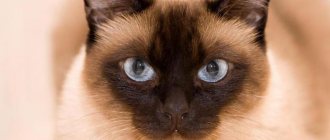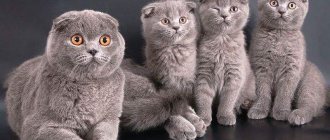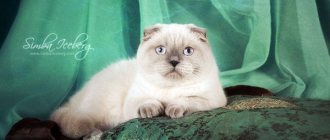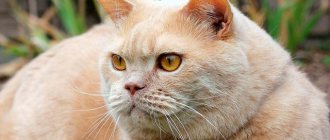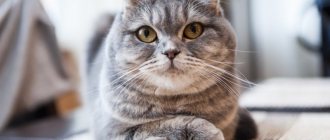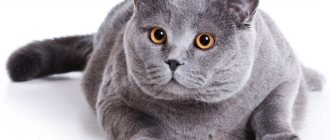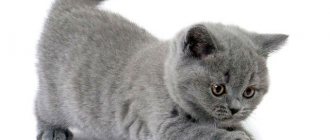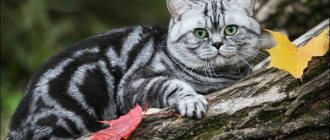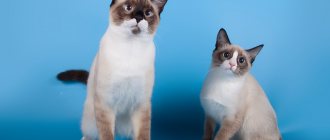Animal selection requires mandatory documentary confirmation. For ease of classification, felinology has adopted codes (encodings) for cat breeds and colors. Coding has general principles and indices.
The breed is designated by three capital English
letters.
The main color is in lowercase English letters
. Color group, eye color, ear shape, tail shape - in pairs of numbers. The encoding must be included in the documents on the breeding origin of the animal (pedigree, metrics). The order of numbers may differ in different felinological systems.
XXX xx NN NN NN (NN)
XXX
– breed code;
xx
– coding of the main color;
NN
– digital designation of color, eye color, ear shape, etc.
In the IFA system, the arrangement of numbers in a color is accepted according to its name, for example, the color “black silver marbled bicolor with yellow eyes” - ns 22 03 62
(
n
– black,
s
– silver,
22
– marbled,
03
– bicolor,
62
– orange/yellow eye color).
Numerical designation of colors (NN – in general coding)
- The number 0 begins to indicate the presence of white in color
- The number 1 begins to indicate the degree of tipping
- The designation of the design variant begins with the number 2
- The number 3 begins to indicate the point color variant
- The number 5 begins to indicate the length of the tail (not always indicated)
- The number 6 begins to indicate eye color (not always indicated)
- The number 7 begins to indicate the shape of the ears.
| White quantity coding (bicolor scheme) |
| 01 – harlequin |
| 02 – harlequin |
| 03 – bicolor |
| 09 – nonspecific white spots (“medallion”, “socks”) |
| Tipped color coding |
| 11 – closed |
| 22 – veiled (chinchilla, cameo) |
| Tabby pattern encoding |
| 21 – indeterminate tabby (for sphinxes, vans, harlequins, color-points) |
| 22 – marble |
| 23 – striped |
| 24 – spotted |
| 25 – ticked |
| Color point color coding |
| 31 – Burmese pointing |
| 32 – Tonkinese pointing |
| 33 – Siamese pointing |
| Tail length coding |
| 51 – tailless (only for the Manx breed) |
| 52 – short tail (for the bobtail breed) |
| 53 – pushed back bob |
| 54 – normal tail length |
| Eye color coding |
| 61 – blue eyes |
| 62 – orange eyes |
| 63 – differently colored eyes (necessarily one blue) |
| 64 – green eyes |
| 65 – Burmese eye color |
| 66 – Tonkinese eye color |
| 67 – Siamese eye color |
| Ear shape coding |
| 71 – straight |
| 72 – ears curled back (curl) |
| 73 – ears folded forward (fold) |
Abbreviated breed names
| ABY | Abyssinian |
| BAL | Balinese |
| BOM | Bombay |
| BRI | British |
| BUL | burmilla |
| BUR | Burmese |
| CHA | Chartreux |
| CIM | Kymrik |
| CRX | Cornish Rex |
| DRX | Devon Rex |
| DSX | Don Sphynx |
| EUR | European KSH (shorthair) |
| EXO | exotic KS |
| GRX | german rex |
| JAV | Javanesian |
| J.B.T. | Japanese Bobtail |
| KBL | Kurilian Bobtail DSh (longhair) |
| KBS | Kurilian Bobtail KSh |
| KOR | korat |
| MAN | Manx |
| MAU | Egyptian Mau |
| MCO | Maine Coon |
| MUN | munchkin |
| NFO | Norwegian Forest |
| NEV | Neva Masquerade |
| ORI | oriental |
| PTB | Peterbald |
| PER | Persian |
| PET | domestic cat |
| RAG | ragdoll |
| RUS | Russian blue |
| SBI | sacred burma |
| SCS | Scottish KS |
| SCL | Scottish DS |
| SFL | Scottish fold DS |
| SFS | Scottish fold KSh |
| SIA | Siamese |
| SIB | Siberian |
| SIN | Singapore |
| SNO | snow shoo |
| SOM | Somalia |
| SPH | Canadian Sphynx |
| TUA | angora |
| TUV | turkish van |
Cost of Scottish Fold
When buying Scottish Fold kittens, it is important to keep in mind that longhaired Folds (Highland Fold) cost up to 2 times more than shorthaired ones. Average prices for Scottish Fold kittens in Moscow are:
Average prices for Scottish Fold kittens in Moscow are:
- Without pedigree: from 4,000 rubles
- Standard: from 10,000 to 40,000 rubles
Video
Sources
- https://ru.wikipedia.org/wiki/Scottish_fold_cathttps://dogcatfan.com/155-scottish-fold.htmlhttps://kot-pes.com/shotlandskij-vislouxij-kot-foto-komok-schastya/https: //petsik.ru/catbreed-scottishfold.htmlhttps://murkote.com/skottish-fold/
Harlequin
The name was given because the owner of the color is similar to a harlequin. The main color of the coat is white. And only ⅕-⅙ of the body area are colored spots. They are not concentrated in one area, but can be scattered throughout the body.
Photos of harlequin cats:
Character of British pets
Representatives of the British breed belong to the category of pets with a difficult character.
- Sociable, but do not allow familiarity. You can pick up a British cat only if she is currently in the mood for it. Any violence or action against the will is regarded as an insult. The cat may proudly walk away, or it may bite.
- The Briton is not prone to active group games. He will most likely stay in a safe place and look down on all the fun.
- Very persistent in expressing their own demands. There are times when cats of this breed do not eat for a long time just because they want to change the place for their bowl.
There is a tendency towards aggression in the behavior of British Shorthairs. But it is never groundless. If the cat does not feel discomfort, then it will not terrorize the household with its bad inclinations.
Plain or solid
A solid color means that there is no additional color either as a base tone or as an undertone. Occasionally, single-colored Scots may have streaks or spots on the face, but the quality of the coat in this case is sharply reduced. In another way, solid colors are called solid, and they come in the following types:
- snow-white. The fur of such cats is perfectly white, the nose is pink, and the eyes are amber or golden;
- black Scottish cats have paw pads and nose that match the color of their coat;
- gray or blue. The eyes of Scots of this color are amber, and the pads of their paws are a covering shade;
- lilac is a mixture of light gray and warm cream;
- a red fold-eared kitten can also be called red, and have a nose and paws of a similar shade;
- Cinnamon kittens resemble saffron milk caps, but their fur is darker in color, similar in shade to rust or the famous spice cinnamon.
Solid colored cats have a number of advantages and disadvantages. As for the advantages, the solid deep color is very much appreciated among show kittens. Moreover, this color is easier to control at the mating stage - it will be easier for you to predict what result you will get.
Pros and cons of Scottish Fold cats
The advantages of the Scottish Fold are:
- appearance;
- thick plush fur, reminiscent of a plush toy;
- calm character;
- cleanliness;
- learning ability
color point scottish fleed
They also have their disadvantages:
- ear parasites due to their characteristic shape;
- picky eating;
- independence from the owner.
As you can see, Scottish cats have more advantages. These animals cannot stand loneliness, for them it is psychological pressure, the animal can become depressed and refuse to eat. Kittens and young individuals are especially vulnerable. Communication with people is critical for them. The character itself is phlegmatic, calm, without excessive activity. At the same time, they are affectionate, patient and good-natured.
I like2I don't like
Shaded colors
The undercoat is almost white, the ends of the hairs are whitish. Almost the entire edge is covered with one color or another, only the chin and abdomen are completely light.
Shaded can be:
Golden. The undercoat is light peach, the fur has a golden glow. The eyes are green, the paw pads and nose are dark chocolate.
Silver. The undercoat is snow-white, the tips of the hairs are dark gray. The eyes are greenish, edged with black. The last feature is characteristic only of the silver variety; other Scottish shaded colors do not have eyeliner. The nose mirror is brick-colored. Black edging of mouth and nose, pads.
Red, aka Cameo. This variety of shaded color has a snow-white undercoat, and there is a dark red coating on the coat. Only the muzzle and chin, the abdomen and the underside of the tail remain completely light. The eyes are like amber. The nose, eyeliner and pads are pinkish.
Patterned
Any color can be patterned.
The shape of the pattern is determined by a series of T (tabby) genes. And such genes are present in the genotype of absolutely every cat. But, as you know, not every cat is striped or spotted. It's all about another gene - A (agouti). This gene either “turns on” or “turns off” as the hair grows, coloring the hairs in transverse rings with alternating dark and light tones. Decoding the colors of cats begins with a search for two genes in the genotype - T and A. If there is at least one A, the cat will be patterned. If there are two aa in the genotype (homozygous recessive set), the fur coat will be colored evenly, since without ticking (coloring the fur in stripes) a pattern is impossible. So, what does the color of a tabby cat mean? The answer is obvious: the cat is a carrier of the dominant agouti gene (A). Now let's look at the tabby gene (T):
Ta (Abyssinian) is dominant to T (stripes), and T is dominant to Tb (marble). But there are still spots! But with them it’s more complicated: either there is a specific gene that allows spotting to appear, or the spots are the result of the work of a group of modifier genes that “break” the stripes (the latter is more likely).
Care and maintenance
The basis of care is a balanced diet.
When purchasing a kitten, you need to ask the breeder what food the animal is accustomed to. Using this food, you can gradually switch to the desired mode. Up to four months, the kitten should eat at least four times a day, after 8 months - twice. If the animal receives natural food, it should include fermented milk products, offal, and lean meat. Do not give cream or natural milk. The former have a high fat content, and the latter is not absorbed by the body of an adult cat. Suitable by-products include chicken gizzards, hearts, and beef liver. Meat – chicken, veal, turkey, rabbit. Pork has a high fat content and can lead to excess weight gain.
As a side dish - porridge. You can give your cat buckwheat, oats, rice. It's great to include vegetables in your diet. They can be raw or boiled. Fish can only be sea, low-fat, boiled. The finished food has a balanced composition, containing all the substances a cat needs. The food can be dry or wet. It is better to choose premium, super-premium, holistic food.
Veterinarians strictly prohibit mixing these two regimens. This can cause problems in the digestive system. Many Scottish dogs are prone to overeating. You should not overfeed your pet - extra calories weaken the heart system. Also, care is important for a cat, which consists of certain hygiene procedures.
brindle tabby
Education and training
A pet is not a soft toy. When bringing home a Scotsman, you need to know the basic rules of communication, keeping, and raising a pet. This breed has developed intelligence and quick wits. You can teach your kitten to simple commands, but you need to know some nuances. A kitten left alone can cause mayhem and chaos.
There is no need to hit or scream at the animal. It will not understand what the owner wants from it. You need to set aside some time and devote it to your pet. You need to buy toys for him, a play corner, tennis balls are perfect. The kitten perceives them as its prey. If you play with him during the day or in the evening, at night the pet will sleep peacefully without disturbing people.
If the kitten starts biting or chewing furniture, this must be strictly stopped. This can be done in a stern voice. If the furniture is suffering, it can be treated with sprays with the smell of citrus fruits; cats cannot tolerate such aromas. Scottish Folds get accustomed to the litter box very quickly, you just need to show them the place of the toilet. Kittens usually understand everything the first time.
Bicolors
The bicolor tartan will be painted in two colors. The first one is necessarily white. The second one can be cream, tabby, black, red, blue. Breed standards require that the double coloring be symmetrical.
Photo of “Scots” bicolor:
spotted tabby
A color in which there are separate spots on the body, ideally clear and not merging, uniform on the sides and back. It is formed with the help of the main Tabby genes and a complex of polygenes that “tear” the pattern into separate spots. Spotted and striped colors often form multiple transitional forms, and all these options are always classified as spotted color, because the stripes tend to “tear” as the animal grows older. Therefore, spotted is the most common color among the British patterned. Marble color is less susceptible to the action of “tearing” polygenes, because this is a wider and denser pattern, so only marble that is completely torn into spots is classified as a stain, while marble that has only been slightly exposed to polygenes will look like marble. In any case, the spotted pattern clearly shows which color was used to form the spot.
| Diagram showing how brindle and merle colors are transformed into spotted colors by polygenes. |
| Various modifications of spotted color | |
| small dots based on ticked color | round polka dots based on brindle color |
| loose large stains based on marble | rosette spots based on marble |
| Modifications of marble pattern (classic and bordered) |
This is true for all patterned colors - they value the correctness and clarity of the pattern. And also, according to the standard, a patterned animal must have a warm undercoat tone, which can vary from light sand to rich beige.
| Quite a contrasting pattern. At the same time, we see an intermediate option between brindle and spotted - dotted stripes along the ridge, the spots are not located in a checkerboard pattern, but in the form of vertical broken stripes, partially turning into spots. |
| Low-contrast blurry, too light pattern, fuzzy spots, blending into the background. Often, such a pattern is obtained as a result of mating with shaded ones, it is like an intermediate option between a chinchilla and a silver tabby, I call it a “hedgehog”. |
| Table showing possible problems with the patterned color using black silver marbled pattern (BRI ns 22) as an example. | ||
| Correct clear pattern, contrasting to the light background | The pattern is tipped like the Russian Blue breed (the hairs at the end have light tips), so it looks as if it was sprinkled with powder | Veil-like, light, not deeply colored, tipped pattern. Intermediate between chinchilla and silver tabby |
Shaded
Shedded (shaded color) is the third variation of typing colors. These cats have ⅔ white hair and ⅓ colored hair. Tipped fur does not cover the entire body, but only the back, sides, back of the head, neck, and tail. White coat - on the belly, chin, and lower part of the tail.
Shedded is represented by coloring pages:
Photo of “Scots” of shaded color:
Ticked
The ticked color differs from the tipped color in that the hair is colored not in two, but in three different shades:
- white on base;
- colored along the length of the hair;
- black at the tip.
Today, the ticked color is the rarest among the Scottish. Due to its lack of prevalence and amazing beauty, its bearers are much more expensive than “Scots” of other colors.
Photos of ticked Scottish folds:
Quite an interesting coloring of Scotch cats: the cat is white, and there are colored spots on its face and tail. Several colored inclusions on the body and paws are allowed. The color of the spots can be not only monochromatic, but also tabby - marbled, striped.
Photos of Van color owners:
Indexation of breeds and colors of the PCA system
CAT BREEDS
Breed group (01) – long-haired cats (LH)
PERS
Persian – Persian
PERC
Persian classic – Persian classic
EXOT
Exotic – Exotic
EXOC
Exotic classic – Exotic classic
Breed group (02) – semi-longhair cats (SLH)
AMCL
American Curl Longhair
BIRM
Sacred Birman
MCON
Maine Coon
NORF
Norwegian Forest Cat
RAGD
Ragdoll
SIBR
Siberian
TURA
Turkish Angora
TURV
Turkish Van Van
BMIH
Burmilla longhair
BRIL
British Longhair
Breed group (03) – shorthair (KS)
ABYS
Abyssinian - Abyssinian
AMSH
American shorthair - American Shorthair
AMWH
American wirehair - American Wirehair
AMCH
American Curl - American Curl
BENG
Bengal -
BOMB
Bombay
BRIT
British - British
BURM
Burmese -
Burmese BMIL
Burmilla - Burmilla
EURO
European - European Ksh (Celtic)
EMAU
Egyptian Mau
CYMR
Cymric
KORT
Korat
MANX
Manx
OCIK
Ocicat
RUSB
Russian Blue
SING
Singapura
SCOF
Scottish Fold
STRS
Scottish Fold Straight -straight
SCOL
Scottish Fold longhair
STRL
Scottish Fold Straight longhair
SNOS
Snowshoe
SOML
Somali
SOUK
Soukoke
THAS
Thai
TONC
Tonkanese
CHAR
Chartreux chartreuse (Carthusian)
JBTN
Japanese Bobtail – Japanese Bobtail
JBTL
Japanese Bobtail longhair – Japanese Bobtail Hari
Breed group (04) – sphinxes (SF)
DSPH
Don Sphynx - Don Sphynx
PSPH
Peterbald - St. Petersburg Sphynx
CSPH
Sphynx - Canadian Sphynx
Breed group (05) – eastern (BC)
HVBR
Havana - Havana
BALN
Balinese - Balinese
ORIN
Oriental - Oriental
SIAM
Siamese - Siamese
JAVN
Javanese - Javanese
Breed group (06) – Rex (RH)
CREX
Cornish Rex - Cornish Rex
DREX
Devon Rex - Devon Rex
GREX
German Rex - German Rex
SREX
- Selkirk Rex
LAPM
La perm shorthair - La Perm
LAPL
La perm longhair - La Perm Hari
Breed group (07) - empirical (EP)
KRBS
Kurilean Bobtail – Kurilian bobtail
KRBL
Kurilean Bobtail longhair – Kurilian bobtail-hairy
MECB
Mekong Bobtail – Mekong bobtail
FLAP
Flappig – flappig
FLAS
Flappig Straight –
FLPH
Flappig longhair – flappig-hairy
FLHS
Flappig Straight longhair – flappig-straight-hairy
CEYL
Celonese – Ceylon
MUNC
Munchkin – munchkin
MUNL
Munchkin longhair – munchkin hairy
BRIL
Britanica – Britannica
FOLM
Folmax – folmax
FOLL
Folmax longhair – folmax-hairy
FOLS
Folmax Straight – folmax-straight
FSLL
Folmax Straight longhair – folmax-straight-hairy
ELPH
Elph – elf
ELPL
Elph long - elf-long
ELPS
Elph Straight - elf-straight
ELPL
Elph Straight longhair - elf-straight-long
BOBS
Bobstale - bobtail
BAMB
Bambino - bambino
BAMS
Bambino Straight - bambino-straight
ULEV
Ukrainian Levkoy - Ukrainian Levkoy
ULES
Ukrainian Levkoy Straight - Ukrainian Levkoy -straight
DWEL
Dvelf - Dwelf
DWES
Dvelf Straight - Dwelf-straight
PCON
Poli Coon - poly-coon
NAPN
Napoleon shorthair - Napoleon
NAPL
Napoleon longhair - Napoleon-hari
Breed group (08) – domestic cats (DC)
HOCL
House Cat Longhair - Domestic longhair
HOCS
House Cat Shorthair - Domestic shorthair
Colors
01
Black
02
Blue 03
Chocolate
04
Lilac
05
Red
06 Cream 07
Black
Tortie
08
Blue Tortie
09
Chocolate Tortie
10
Lilac Tortie - lilac tortoiseshell
11
Sorrel
12
Cinnamon
13
Fawn
14
Sorrel Tortoiseshell
15
Cinnamon Tortoiseshell
16
Fawn Tortoiseshell
17
Black smoke
18
Blue smoke -smoky
19
Chocolate smoke - chocolate-smoky
20
Lilac smoke - lilac-smoky
21
Red smoke - red-smoky
22
Cream smoke - creamy-smoky
23
Black Tortie smoke - tortoiseshell-smoky
24
Blue Tortie smoke - blue-cream-smoky
25
Chocolate Tortie smoke – chocolate tortoise-smoky
26
Lilac Tortie smoke – lilac tortoise-smoky
27
Black silver – silver-black
28
Blue silver – silver-blue
29
Chocolate silver – silver-chocolate
30
Lilac silver – silver-lilac
31
Red silver – red cameo
32
Cream silver – cream cameo
33
Black Tortie silver
34
Blue Tortie silver
35
Chocolate Tortie silver
36
Lilac Tortie silver
37
Golden Black
38
Golden Blue
39
Golden Chocolate - golden chocolate
40
Golden Lilac
41
Golden Black Tortie
42
Golden Blue Tortie
43
Golden Chocolate Tortie
44
Golden Lilac Tornie
45
White
00
Any unrecognized color - unrecognized color
Drawings, placement of spots and marks (tabby, patterns)
VN
Van – van
AR
Harleguin – harlequin
BC
Bicolour – bicolor
WH
Snowshoe – white paws (snow shoe)
WM
White medallion – white medallion
WP
Unspecified amount of white – white markings
MT
Mitted – mitted
MC
Mink
SH
Shaded
SL
Shell veiled
AG
Agouti
MR
Blotched tabby
TR
Mackerel tabby
PN
Spotted tabby
TC
Ticked
BR
Burmese shading pattern
TS
Tonkinese shading pattern Tonkinese markings (mink)
SM
Color-pointe pattern – Siamese markings (color-pointe)
Eyes
A
Blue eyed
B
Orange
C
Odd eyed
D
Green
E
Burmese eye color
F
Tonkinese eye color Mink eye color
G
Siamese eye color Siamese eye color
Ears
PY
Straight ears
SY
Folded ears
ZY
Curled ears
Tail
r
Rumpy - tailless
z
Rumpy riser - remainder of the tail 1-2 vertebrae
s
Stumpy - remainder of the tail 3-4 cm (bob)
l
Longie - normal tail
Legs (legs)
sl
Short legs - short legs
nl
Normal legs - normal legs
See also PCA Standards | About PCA Cat Clubs
Share the page with your friends on your social networks. networks with one click:
Tabby
The most common group of Scottish coat colors, which is further divided into subcategories:
- shaded - marble coloring;
- mackerel - tiger coloring;
- spotted - spotted coloring.
As for color variations, the tabby is represented by the following:
- silver (black pattern on a cold steel background);
- cameo (bright carrot stripes on a white background);
- silver-blue (gray pattern on a cold steel background);
- cream (dark beige pattern on a delicate cream background);
- red (bright red pattern on a warm peach background);
- blue (rich gray pattern on a silver-beige background);
- cinnamon (black design on a copper background).
Photos of Scottish tabby cats:
Chinchilla
Another variation of the tipped color: only a certain part of the hair is colored, and the base is white. If smoky cats have ⅔ colored hairs, then chinchillas have only ⅛ colored hairs. Because of such an unusual coloring, it seems that the white Scottish Fold has an unusual color coating. The chinchilla color comes in variations:
- golden;
- silver;
- blue golden.
The last type is the rarest, which is why its owners are the most expensive.
"Scots" chinchilla colors:
Tortoiseshells
The English name for the color is torti. On the fur of the “turtles” dark spots are intricately combined with light ones. The variegated coloring must be distributed evenly over the body, which distinguishes torties from tricolor cats.
In Scottish Folds, the “tortoise” pattern occurs in variations:
- black-red;
- creamy lilac;
- chocolate red;
- creamy blue.
Interestingly, only cats can be “turtles”. In cats, this is a genetic mutation indicating infertility.
Scottish fold tortie color:
What colors are there on a cat's fur?
There are two basic cat colors: black and red. The remaining colors are a mixture of genes responsible for melanin, a special pigment that forms different shades of colors.
All coat colors of domestic cats come from only a few basic colors, which when mixed produce different shades. Most colors are found in both outbred and purebred animals, but the selective work of breeders has led to the fact that some of their types can appear only in cats of a certain breed. At the moment, the concept of color covers the color of an animal’s coat, various degrees of coloration, as well as the pattern on the coat.
White color in cats
It is believed that white cats bring happiness to the home. Wool of this color is found in representatives of different breeds. Snow-white Persian cats, especially blue-eyed ones, are highly valued. White cats with different colored eyes are extremely rare.
Among white cats, there are those with blue eyes - sometimes this is a sign of poor hearing or even deafness.
Photos of white cats of various breeds
Photo of the Highland Fold breed white color
Photo of a white oriental breed kitten
Gray (blue) color of cats
There are legends according to which cats with silver fur are the best protectors from trouble. They protect the home and bring happiness. Among silver colors, the most common is smoky, in which the hairs at the roots are painted white and closer to the tips - gray. The most famous representatives of the gray color include cats of the British breed with green and orange eyes.
Photos of cats (cats) of blue (gray) color
Photo of a cat of the British breed blue color
Photo of a Russian Blue cat
Tortoiseshell color
Pets with a similar coat color have a combination of random spots of tan (red) and black tones throughout the body. There are practically no inclusions of white color. The pattern on the fur is formed randomly from these colors, so that a complex and unique color is formed for the pet. It is interesting that tortoiseshell color is found almost exclusively in cats.
Color in animals is formed at the genetic level. Cats naturally have two X chromosomes, while cats have one X and one Y chromosome. Since the X chromosome is responsible for the formation of red and black coat colors, the appearance of a red-black combination in cats is high.
In cats, one of the colors appears, and therefore the tortoiseshell cat is considered an anomalous phenomenon. They usually have violations of the genetic code, suffer from pathologies of the endocrine and reproductive systems, and live no more than two to three years.
Black color
Mysticism and superstition have surrounded cats of this color since ancient times. Whatever they were called: accomplices of Satan, talismans of magicians and witches.
Photo of an oriental black cat
Some people even today believe in the sign of a black cat crossing the road and promising an unlucky day. In Scotland, on the contrary, black pets are respected, believing that they attract wealth. It is widely believed that black pets can heal illnesses and bring peace to the family.
Two-color
Officially, two-tone color (bicolor) was recognized quite recently; before that, such cats were considered as defective. These pets are believed to have a friendly nature.
Two colors in color are often found in cats of Persian and British breeds. Breeders are happy to breed Angora and Siberian cats - the variety of their colors allows you to get kittens of the most unusual colors.
Ginger
Since ancient times, red cats have been considered healers and protectors. The “sunny” beast, according to legend, brings wealth, fun and joy to its owners.
Red cats are considered very cunning. Red-haired robbers do not let their owners get bored, they are constantly playing pranks. At the same time, they are very affectionate.
Tricolor color in cats
Calico cats are believed to bring good luck. White pets with red and black spots are especially popular.
In Japan, a figurine of a tricolor cat with a vertically raised paw is placed at the entrance to the house: then it will bring wealth and prosperity to the owners.
It is surprising that among the animals marked with this color, there are almost no males.
Colors
| a | blue, blue point (a 33) |
| b | chocolate, choclit point (b 33) |
| c | lilac, lilac point (c 33) |
| d | red, red point (d 33) |
| e | cream, cream point (e 33) |
| f | black tortoiseshell, tortie point (f 33) |
| g | blue-cream, blue cake point (g 33) |
| h | chocolate tortoiseshell, choclit torty point (h 33) |
| j | lilac tortoiseshell, lilac tortie point (j 33) |
| n | black, seal point (n 33), ebony (for orientals) |
| o | sorrel, cinnamon |
| p | beige background |
| q | tortoiseshell sorrel |
| r | tortoiseshell, beige background |
| s | smoky, silver |
| w | white |
| y | gold |
| x | unrecognized color |
Smoky
Other names for the color are smokey and smoky. This is the so-called typing color: the base of the hair is light, almost white, and the tip is dark.
Among the Scots, smokey is classified as silver. The color does not allow patterns on the coat - brindle, spotted, tortoiseshell. It is easy to distinguish a smoky color from a solid color - you need to part the fur. In a smoky, it is ⅔ colored - the base of the hairs is always light.
The main variations of “smoke”:
Photos of smoky Scottish folds:
Solid
This coat coloring is also called plain, solid. The main feature is that the coat is uniformly colored in one color, without even the slightest inclusions of a different tone. The color is equally saturated along the entire length of the hair.
Solid suits of the “Scots”:
- blue (gray-silver);
- ebony (all black);
- red (red);
- white;
- cream;
- chocolate (rich brown color);
- cinnamon (cinnamon tones);
- lilac (beige with a lilac, pinkish tint);
- “fauns” (beige, piebald).
The most classic color for Scottish cats is blue.
Photos of Scottish cats of solid colors:
